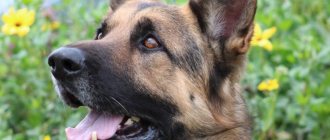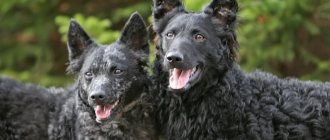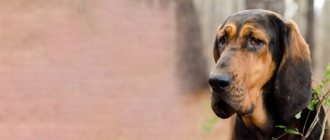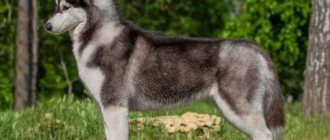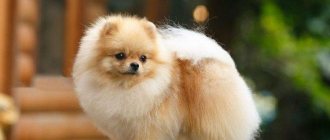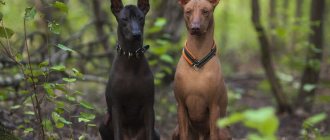Some dog breeds are familiar to us; they are easy to recognize in photos and when we meet them. But there are also those that are not very widespread and famous, so learning about them is especially interesting. For example, the Hungarian Pumi is a perky and devoted representative of this breed..
- 2 Description of the breed
2.1 Character and psyche - 2.2 Disqualities and disadvantages
Pumi care and dog maintenance
It must be said that these interesting dogs are poorly adapted to living in apartment conditions. They are too energetic, mobile and loud-voiced. They are hyperactive, constantly on the move, accompanying all their movements with a ringing bark. It is this incessant barking that always causes a lot of complaints from neighbors. Therefore, the best place for these animals to live is the countryside or a country house, where there is always the opportunity to run around and bark to their heart's content without causing inconvenience to others. These shepherds feel best on a farm, in the forest or in a pasture.
Caring for a Pumi will require some effort.
But it is important to brush your pet's coat regularly and trim it occasionally if necessary. Be prepared to give your dog a thorough brushing routine at least two days a week, which will help prevent his hair from forming mats and tangles. Pumi also needs bathing and grooming every three to four months. After water treatments, her coat should dry naturally and then it will curl on its own.
It is recommended to keep your dog's coat between 1 ½ and 3 inches (4 to 8 centimeters) long to ensure he always looks neat. The rest of the care consists of such regular procedures as trimming nails and brushing teeth. Periodic cleaning of dog ears is a good preventative measure against ear infections and various types of irritation.
Health and life expectancy
Pumi are naturally strong and resilient. Most dogs can boast of good health and only in adulthood begin to suffer from the usual diseases of old age. But there are also those who are less fortunate. There are several characteristic hereditary diseases in the breed. To prevent their spread, breeders continue to test dogs for the presence of pathologies and, if they are detected, exclude the animal from breeding work. The list of these diseases includes:
- Hip dysplasia;
- Patella dislocation;
- Primary lens luxation;
- Generative myelopathy;
- Dysplasia of the knee joint.
To maintain the health of Pumi, preventive measures are important, which include vaccination, annual medical examination and regular treatment for external and internal parasites. Pumi's lifespan is usually 12 and 15 years.
Care and maintenance
The Vizsla feels good both when living in a house with a large plot, or in an apartment, but only if it takes long, regular walks in the morning and evening, as well as active exercise for at least 2 hours a day.
Pictured is a wire-haired Hungarian Vizsla
This is necessary for the dog to release energy, otherwise it will begin to look for a substitute for physical activity (running after cats, digging holes, gnawing things) or become bored, which is fraught with illness. The more energy she spends on a walk, the calmer she will be at home, the more secure her things will remain.
To raise a full-fledged family member who will obey the owner and household members, the Vizsla must be trained from early childhood. In the future, all walks must be combined with elements of training. When walking without a leash, the dog's hunting instinct may suddenly awaken, and it will rush after a cat or pigeon, regardless of obstacles or dangers in the form of cars.
You should always keep her on a leash when walking around the city or near roads. It is very difficult for a vizsla to get lost; she always tries to keep her owner in sight, works in his sight, and accepts praise with pleasure.
The dog loves children, she is patient and caring. But given its size, children should be supervised while they play with their pet. Hungarian Vizsla puppies require as much attention as other breeds.
Vaccinations, anthelmintics, trimming of overgrown nails, combing, especially in adults. The Vizsla's fur sheds constantly, this becomes especially noticeable during the spring and autumn molt.
The only way to cope with the ubiquitous thin short hairs is by timely combing with a rubber glove brush. Nails are trimmed once a month with a large nail clipper.
They love to swim always and everywhere. It is advisable to let them frolic only in large bodies of water with running water. Ponds with stagnant water contain many parasites that can penetrate your dog's skin or intestines.
Pictured are Hungarian Vizsla puppies
After swimming in a pond or walking through mud, you should rinse the coat with warm water and, if necessary, wash with shampoo. There is no need to use shampoo often, as this dries out the skin.
Characteristics of the breed and its features
The Hungarian Kuvasz served man for many centuries, protecting his herds and flocks, property and family. This breed is a stern protector who clearly divides everyone around him into strangers and family members. Moreover, this division applies not only to people, but also to domestic animals, poultry and other inhabitants of the farmstead.
Like the Central Asian Shepherd Dog, the Kuvasz is an excellent guard of territory, and the size of the territory can be huge. In Hungary, several dogs often guard entire villages, walking around their perimeter and preventing animals or strangers from approaching.
Kuvasz is an excellent territory guard, and the size of the area can be huge.
One of the striking features of the breed is its complete reluctance to work on a leash or chain. Kuvasz recognizes only free guarding, relying on their own vision and hearing, as well as the ability to make decisions independently. This quality makes it almost impossible to keep dogs of this breed in apartments, as well as to live in urban conditions on a small plot.
Kuvasz must feel free, otherwise the dog begins to get sick, his character deteriorates and becomes unpredictable. This giant simply requires work, a sense of will, and movement. Many representatives of the breed, not wanting to sit within a small yard, escape, considering the entire territory of the surrounding area to be their area of responsibility.
In relations with household members, the Kuvasz shows friendliness and restraint, as it perceives members of its owner’s family as part of the objects entrusted to it for protection. He is very reserved towards children, especially toddlers, does not want to participate in games, and avoids children. He truly respects the owner and obeys unquestioningly, but for this you need to be an authority for the dog. Kuvasz is not prone to dominance, but will not listen to a weak-willed owner, considering it unnecessary to follow his commands.
Aggression towards strangers is always present in dogs of this breed, so keeping a Kuvasz requires a strong fence and a durable enclosure where you can lock your pet if necessary. Usually the Kuvasz calmly obeys the owner, but if the person’s authority is weak, the dog may ignore commands or attack the owner, considering his order to be erroneous.
Having bitten, the kuvasz jumps back to attack from the other side, moves very quickly, knocking the enemy down. The dog always uses the power of his powerful jaws, literally tearing the muscles of the enemy during an attack. The owner must constantly monitor the pet to prevent a sudden attack on passers-by on the street.
In relations with household members, Kuvasz shows friendliness and restraint.
The Hungarian Kuvasz, especially the male, can show pronounced aggression towards dogs he meets. Keeping two males of the same or different breeds together will also lead to regular showdowns and fights.
Subtleties of training
A Kuvasz puppy, which grows very quickly and matures only by the age of three, must go through all stages of socialization and an obedience course before the age of one year. The baby is brought out into the world very early, immediately after completing quarantine for vaccinations. The street, city noise, strange smells and many strangers, dogs he meets - all this teaches the baby to treat irritants calmly.
Already at four months you can start visiting a training area, where the puppy will see how other dogs react to commands, get acquainted with puppies of the same age, and learn to communicate. Persistent and patient training is required, without nervous breakdowns on the part of the owner and physical punishment.
During training, not only the puppy learns, but also the owner learns to correctly understand the non-verbal signals of his pet. In addition, the training process increases the authority of the owner and teaches the puppy to obey commands.
Kuvasz needs to be socialized and brought out into the world.
A one-year-old Hungarian Kuvasz, whose character is going through a difficult transitional period of puberty, must definitely visit the playground
It is at this time that you should pay attention to the pet’s increasing aggressiveness in order to direct it in the right direction. There is no need to suppress or beat the Kuvasz, otherwise the trusting relationship that is so necessary for raising a dog with a complex character will be lost
The pet will become stubborn, become embittered, and aggression towards the owner is possible.
Care and maintenance
Petit Brabançons are not “street” dogs, so life in a kennel is not for them. These small companion dogs should be kept in a city apartment. A private house is also suitable, but only if it is cozy, warm and without drafts. A Brabançon can be trained to go to the toilet “like a cat,” that is, in a tray. However, this does not eliminate the need to take your pet for a daily walk. Spending time outdoors is necessary for griffons to stay in good physical shape and is good for their mental health.
Given their natural sociability, communication with other dogs is vital, and this is mainly possible during walks
The Brabant Griffon does not require any special care: it is enough to brush the dog daily. Bathing procedures should be carried out only when soiled. After bathing your pet, you should not leave the fur to dry on its own; it is better to dry it with a hairdryer so that the griffon does not freeze or catch a cold. For the same reason, it is not recommended to bathe him in winter.
Brabançon ears need regular cleaning once a week. For this purpose, a regular 3% hydrogen peroxide solution is used. When treating the ears, do not penetrate deeply. If there is an unpleasant odor coming from the ears or if there are dark crusts on the inside of the ears, and the dog “fidgets” when cleaning, you should immediately contact a veterinarian. Such phenomena may indicate the onset of a serious illness, which can be cured with the right treatment and good care.
Feeding your Petit Brabançon can be difficult as it is quite picky and will only eat the foods it likes. It is recommended to immediately buy a special bowl on a bracket for your pet in order to adjust it as the dog grows to maintain posture
It is important to adhere to the diet, give food at approximately the same time, and do not overfeed the griffon. Until 6 months of age, puppies are fed in small portions, 4-5 times a day, and then gradually reduce the number of meals to two
If you plan to feed your Petit Brabançon with natural products, include in the diet:
- lean meat (veal, turkey, lamb),
- porridge (rice, buckwheat, oatmeal),
- fruits and vegetables,
- eggs,
- fish fillet without bones,
- cottage cheese, kefir, yogurt.
Be sure to add vitamin and mineral complexes to the main menu and monitor your Brabançon’s weight.
However, the vast majority of Brabant Griffon breeders opt for ready-made dry food. Super-premium and holistic products are completely balanced in composition and do not require the purchase of additional dietary supplements. Drying is ideal for Petit Brabançons for small, active breeds.
Nutrition
When feeding Pumi, it is very important to adhere to the diet and feed Pumi at the same time. The dog should not overeat . Puppies up to two months need to be fed six times a day, up to six months four times, and from one year onwards - twice a day. Pumi can eat both natural products and balanced dog food. With natural feeding, the dog’s diet should contain meat and offal - at least 60% of the diet, and the dog should also eat cereals, vegetables, dairy products, eggs, and fruits.
You cannot feed your dog table scraps, and your dog should not eat sweets, baked goods, pickled or smoked foods. Water should always be freely available.
Character and temperament
The Hungarian Vizsla goes through life for quite a long time exclusively next to a person. By working together, they learned to understand people well and, as a result, turned from an ordinary working dog into a reliable companion.
Today, the need for breeding exclusively game animals has significantly decreased. This type of recreation is no longer so popular, and modern people no longer need to hunt game for food. In addition, not everyone can afford to own a purebred hunter. However, this did not affect the Hungarian pointer, since in addition to its hunting qualities, it has a number of advantages that any family will appreciate.
Another advantage of this breed is its kindness. These animals are equally friendly towards all people. They are open to communication and easily get to know guests, which means they are not very good security guards. A cop would rather get acquainted with an intruder than rush to defend the territory from a thief. The only thing such a security guard can do is to warn with his voice that a third party is approaching.
This dog will always happily greet you at the entrance, and the time of absence does not matter at all. Not all animals are capable of such a rich range of emotions. Sometimes it seems that they are smiling, and their eyes simply sparkle with boundless love. When greeting, the dog behaves very emotionally, he squeals, whines and barks at the same time, he also jumps affably and wags his tail very actively.
The Hungarian Shorthaired Vizsla loves children and can be an excellent nanny. She is patient and does not show aggression. Children of any age quickly find a common language with such pets and easily involve them in their games. Dogs, in turn, are very happy to keep the little fidgets company, since they themselves don’t mind frolicking. Due to their enormous patience, lack of aggression and loving nature, cops are often used in the therapy of sick children. Representatives of this breed always cope perfectly with the role assigned to them.
Character[ | ]
The character of Pumi is active, energetic, they have an excitable temperament. They are people-oriented and very affectionate, easy to socialize. They treat strangers with distrust, but without aggression. After the dog gets used to the new person, it will easily contact him, including in the absence of the owners[1].
Very playful both as a puppy and as an adult. They are also characterized by an active manifestation of curiosity. In the temperament of these dogs, the processes of excitation significantly prevail over the processes of inhibition, as a result of which they are gambling and addicted animals. This can create difficulties in mastering commands, as dogs easily switch their attention from work to the surrounding area. This also leads to the fact that even a well-trained dog of this breed is extremely difficult to stop by giving a command, so when training with them it is very important to focus on developing obedience and attention to the owner[6].
Also, due to their temperament and high activity, pumas are prone to noise and destructive behavior, so they require the organization of a long walk with a variety of mental and physical stress throughout the entire walk. While staying at home, and especially in an apartment, they need to ensure that they have a large number of toys that are attractive to the animal, and also from time to time offer them various types of activities that can captivate the puma and cause it to waste its energy. These dogs are practically contraindicated to remain alone for a long time, so those who spend little time at home should not get a Pumi[1].
It is worth noting that Pumi, as a herding breed, are prone to grazing, including when kept at home. This is expressed in barking and possible biting of people and animals that are moving quickly or moving away from the dog, as well as similar actions towards family members, including children. In this case, the dog does not show aggression, which is completely unusual for them, but strives to bring together and calm those whom it considers its charges[6].
In addition to the herding instinct, the Pumi also has a well-developed protective territorial instinct. As a rule, this is expressed in barking at strangers when they approach or enter the territory, as well as in actively guarding the territory. They have a good sense of smell and are highly attentive to these actions, which, among other things, can distract them from learning or performing other commands[1].
Despite all their contact, affection and sociability with family members, Pumi are quite capricious and independent in decision-making. At the same time, they are not characterized by the manifestation of dominant aggression and harsh attempts to establish a social hierarchy in their favor. They do not show aggression towards children and other pets, but may demonstrate a hunting instinct towards rodents[1].
Pumi are highly intelligent and, despite their personality traits, can demonstrate very high performance in learning and training. They are able to remember a large number of commands and complex complex actions that require the dog to perform a number of tasks within the framework of one given command[1].
Related breeds
Weimaraner
Weimaraner and Hungarian Vizsla
The Weimaraner captivates at first sight with its silver-gray coat color and amber eyes. In addition, they are considered the “blue blood” of the canine world for their high level of intelligence, excellent memory and ability to make independent decisions.
Weimaraners are called the intelligentsia of dogs. They are very delicate and have good manners. They love communication and are quite friendly, although we must not forget that these are hunting dogs and malice is in their blood. In addition, these dogs have a very freedom-loving character and do not tolerate being kept locked up. They want to be accepted as part of the family. And somehow calling a Weimaraner a pet doesn’t work either. She is too smart and quick-witted, besides, she is easy to train and can easily perform some household duties. This is the character of these silver German dogs with very smart eyes. That is why their price around the world is quite high.
Education and training
The breed has a high level of intelligence, so raising such a pet is easy and quite simple. Vizslas are happy to follow any commands, they do not need to be repeated twice, however, tasks must be meaningful, as they like to make their own decisions.
If a dog is purchased for hunting, then from an early age the baby must pass a test for professional suitability. To do this, a small piece of a bird is tied to the end of a stick and the puppy must react to it. If during the test the future hunter takes a characteristic stance, then it means that he can safely be taught hunting habits.
Starting from six months, the puppy should be taken hunting with you so that he gets used to the environment, noise and foreign smells. There, the puppy must get acquainted with game and learn the basics of hunting behavior. You shouldn’t wait until he reaches full maturity; the sooner the puppy begins to learn the specifics of the job, the better he will perform on the hunt as an adult. By the age of one year, the pet should be able to follow a trail, navigate the environment well, and unquestioningly obey the owner’s commands.
The main advantage of this breed is the ability to “hear” its owner. A cop never loses contact with a person, even if he gets excited and seems to have no control over himself. It is easy to keep her under control, teach new skills and correct behavior.
During training, it is not recommended to use the whip method. These animals are very sensual natures, they are vulnerable and do not accept rudeness. Any manifestation of physical violence is perceived painfully. It is better to pronounce commands in an even voice, without signs of irritation or impatience. It is advisable to reinforce any success in learning with tasty encouragement and kind words.
Key points in training
The Hungarian Vizsla is a highly intelligent dog, it learns quickly and does not strive for leadership in tandem with its owner. The cop is obedient, especially if raised from childhood. It’s easy to get her interested in play training. It is better to motivate the Vizsla with toys; goodies are also suitable, but balls, rings and other attributes will be a real joy for the dog.
It is not necessary to train the Cop to hunt; she has innate skills in finding and catching game. But special training will further reveal the animal’s potential.
The Vizsla puppy is kept indoors for up to 3 months. At this time, you can give your baby all the basic rules of behavior. The dog must know the feeding and walking schedule and follow the regime. The pet needs to learn its name, basic commands (“sit”, “lie down”, “no”, “place”, “next to me”, “to me”).
Education and training
“Portuguese” are active and inquisitive dogs, so they are happy to learn something new. But if they don’t like the training methods, they will definitely show their character. This is why dog experts recommend starting training soon after the puppy arrives in the house.
Greyhound (dog): description of the English greyhound breed
It is a misconception that puppies do not perceive the flow of information. In fact, already at 2 months the dog is able to perform a set of basic commands. Early socialization will also allow the pet to understand how to behave correctly in society. This requires taking the dog out for walks regularly among people and other animals.
To conduct specialized training, you will definitely need to consult an experienced dog handler. It is recommended to begin serious training from 6 months; at this age, the water dog is already intelligent, smart, assiduous and incredibly smart.
It is necessary to first draw up a set of creative and creative tasks aimed at developing physical skills and developing intelligence.
Appearance
Due to the fact that during the Second World War the breed was on the verge of extinction, it had to be restored literally from scratch, modifying the standard to bring it as close as possible to the original image.
Color
There are several recognized colors: brown, black, white, ash, merle, and their variations: for example, brown and ash merle. Sometimes there are puppies with tan, “wolf” or brindle coloring. Pale yellow merle may appear. But first of all, all the colors of the Hungarian Shepherd Mudi are even. Interestingly, the solid color is obtained thanks to the dominant K gene. This gene does not allow the appearance of brindle or black-red-white, which is present in the husky.
Standards
- General appearance: proportional body structure, small size. Males - 43-45 cm, females - 40-42 cm.
- Weight - 8-13 kilograms.
- The coat is wavy on the body, smooth on the head and front legs.
- The head is wedge-shaped, the forehead is sloping, the back of the head is flattened.
- The skull is dome-shaped.
- The muzzle is elongated, less than the entire length of the skull.
- The nose is narrow, rounded towards the nose. The color is black in both white and black dogs. The rest have brown lobes or the color of their fur.
- Lips are tightly adjacent, the line of the mouth drops slightly when moving to the neck.
- The teeth are small and have a scissor bite.
- The eyes are almond-shaped, set at a slight slant. There must be only dark eyes, blue are acceptable in the merle color.
- The ears are erect, like those of German Shepherds, with thick hair.
- The body is compact, the back is always straight, muscular, and slopes down to the croup. The height of the withers is approximately equal to the length of the body.
- Neck - located at an angle of about 50 degrees to the spine, muscular, strong, no collar. Males have a mane.
- The chest has a slight curve in front, the ribs are flattened.
- Tail - set high, long, hanging, with thick hair. When the dog moves or is happy, the tail takes on a crescent shape. Docked tails are acceptable.
- Paws are medium-sized, with pronounced muscles, black claws, round paw pads.
Choosing a puppy
Since the Hungarian Kuvasz is a working breed of dog, the puppy is selected based on the child’s inclinations in accordance with the category. The puppy should be large, bony and strong. In addition, be extremely inquisitive, fearless and hyperactive in order to become a real protector of the owner, as well as his family and property.
In addition to curiosity, the puppy must show sincere curiosity, absolute calm without a shadow of embarrassment, with which he explores every new object, for example, kennel guests
You should not focus your attention on a hiding, inactive puppy.
As a puppy, the Hungarian Kuvasz is a true athlete. His muscles are well developed, his limbs are large, thick, smooth and strong with a strong stance. The coat is short, but fluffy and shiny. Eyes and ears are clean. The head is much larger than the body, but the puppy looks more harmonious than disproportionate. A puppy, structurally resembling an adult, loses bones with age, becoming a poor-boned, small dog.
Nicknames and names
When purchasing a Kuvasz puppy from a kennel, please note that the documents include his name with the factory prefix. This is the official name of the dog assigned to Kuvasz according to the breeding activities of the kennel and the international canine community
The owner can freely assign a pet name to the dog. But it will not appear in any document.
The name for the Hungarian kuvasz is selected depending on personal preferences. You just have to remember that the sound of the dog will sound every day and several times a day. Therefore, the name should appeal not only to family members, but also, first of all, to the dog.
Kuvasz breed price
This breed of dog is considered valuable in many countries of the world, but despite the fact that many potential buyers love it and want to buy it in Russia, there are not many professional breeders involved in breeding such animals.
Buying a Kuvasz in the CIS is also extremely difficult, because kennels for breeding this breed of dog are quite rare here, and to purchase these animals you have to look for them abroad. The price of kuvasz usually does not fall below 50,000 rubles. But a purebred puppy can cost much more, and its cost for connoisseurs of purebred dogs sometimes reaches up to 150 thousand rubles.
Origin story
Descendants of the wire-haired Hungarian Vizsla were mentioned back in the 10th century. Representatives of this breed were described in the Viennese chronicle in 1375; they were great hunters and hunted small fur-bearing animals. Local residents of that time admired the working qualities of animals, their beauty and aristocracy. Their main location was concentrated in the Hungarian Carpathians.
Over time, the pointer became a universal gun dog that performed well in any conditions, be it a swamp, a dense forest or a bare clearing. Based on this breed, excellent hunters were bred in some European countries and in England. Some researchers believe that certain types of Arabian greyhounds, such as the Saluki, took part in the development of the breed.
As a result of competently done work, the Vizsla became an ideal hunting assistant. This animal contains all the most necessary qualities; it has a high level of intelligence and amazing endurance.
In the Middle Ages, the pointer was very highly valued by the local population, however, not everyone could afford such a dog. As it turns out, this privilege belonged only to the eminent nobility, who were fond of horseback hunting with dogs. For this reason, the breed has practically not undergone any changes, both externally and internally, because all matings were planned and competent work was carried out.
In modern history, the first recorded data on the breed dates back to 1825. It was from this period that any breeding activities began to be recorded and entered into the stud book. It is this period that is considered the dawn of the wirehaired pointer in Hungary. The dogs gained worldwide fame a little later, since for a long time there was a state ban on the export of Vizslas. Consequently, all valuable specimens remained within the country and were successfully used by the local population.
Pumi's in heat
- age of onset of the first estrus in a female is 6-12-14 months;
- duration of estrus is 20-22 days, sometimes up to a month;
- frequency of estrus – 1-2 times a year with an interval of 6-9 months;
- signs of estrus – swelling of the dog’s external genitalia, spotting;
- frequent urination - having to walk more often than usual;
- psychological signs - a change in the dog’s behavior - from aggressive to lethargic;
- perhaps there is a change in appetite and the dog drinks more water;
- often bitches begin to shed before going into heat;
- lick the loop intensively.
You can notice the approach of estrus while walking your dog. Behavior can change, often the dog becomes active, playful and disobedient, or, on the contrary, looks unhappy and lethargic. The bitch makes frequent marks - scent “lures” for male dogs, and urination occurs more frequently. The loop becomes more and more swollen; when pressed, you can see a discharge of light pink or dull pink color. If you notice changes in the dog's behavior, do not be lazy and check the dog every day for the onset of heat by dabbing the bitch's loop with a napkin or toilet paper. Pinkish discharge will be the beginning of estrus - mark this day in your dog’s notebook.
The course of the dog's first heat.
- The first heat in dogs is not the same as the next one.
- It may be shorter or longer than the usual estrus period.
- The bitch has either only weak manifestations of estrus, or, conversely, very heavy discharge.
- The first heat may suddenly stop, and then after some time begin again.
- There may be mucous discharge from the loop, a smell that attracts males, and the estrus itself will begin after some time.
- Try not to miss the start time of the first, and subsequently the second estrus, in order to correctly determine the intervals between estrus and know their timing and duration.
Precautions during estrus. If you are not interested in getting puppies from a dog, you need to take precautions during heat:
If you are not interested in getting puppies from a dog, you need to take precautions during heat:
- walk your dog ONLY on a leash: even the most obedient dog these days can simply run away, not paying attention to commands;
- do not allow male dogs to mount the dog: if sexual intercourse begins, it is almost impossible to separate them;
- during a walk, literally DO NOT take your eyes off the dog, even when buying bread in a tent, eliminate or minimize contact with male dogs;
- there is a danger of the dog catching a cold in the cold season, the best way to protect yourself is not to walk for a very long time in cold weather and use dog clothes;
- If your dog lives freely on your territory, then from the moment the estrus begins, lock the dog in an enclosure.
Personality of the South African Boerboel
Boerboel with its owner
Buying a Boerboel is a big lottery, since due to commercial breeding the character and temperament of the animals have undergone serious changes. So, for example, having bought two puppies from different nurseries, there is a risk of raising a pair of classic antagonists, one of which will be the embodiment of prudence, and the second - a bundle of aggression. So before purchasing a dog, it would be a good idea to clarify which breeding lines the breeder specializes in: fighting or classic.
If we talk about the ideal Boerboel, then he should, first of all, be manageable, balanced and friendly towards all family members without exception. Don't expect a representative of this breed to be delighted with strangers, but he shouldn't tear their trousers to shreds either. A socialized, well-mannered dog may remain somewhat distant while you are chatting with a stranger, but rest assured, he is carefully scanning your interlocutor all this time. One threatening gesture towards the owner - and the pet turns on full combat readiness, attacking the intruder.
A Boerboel can adore its owner to the point of madness, but at the same time it will not miss the opportunity to crush him under itself. Prepare in advance for this confrontation, which usually begins in adolescence. This is not a decorative fluffball whose attempts at leadership evoke tears of sincere affection, but a serious “fighter” who recognizes only the cult of strength. If a dog does not respect its owner, sooner or later it will enter into open conflict with him. Well, it’s not hard to guess how Boerboel’s clashes with humans usually end.
If the South African Boerboel gets disrespected from anyone, it's children. He won’t make a professional babysitter (not the right temperament), but being friends with babies is absolutely not a burden for the “African”. On the other hand, you should not unconditionally rely on the good nature of such a large and serious dog, so constant control over the time spent together between the child and the animal must take place.
Do not perceive the Boerboel as a dull guard, suitable only for official work. Yes, he is not a genius, but he is smart enough not to create problems for you in everyday life. In addition, do not forget that this is a breed whose intelligence needs to be constantly developed. If you communicate and train with your dog a lot, you will get a calm and smart assistant. If you give your pet the opportunity to hone its security qualities on its own, get ready to live next to an uncontrollable dominant who does not recognize any authority.
Collecting energy from a person, how to protect yourself
We will look at several rules that will not only keep your energy intact, but also protect you from any outside influence.
- If you understand that a person is an energy vampire, then try to avoid him by any means. You can simply not answer his calls, interrupt communication at the moment when he is trying to somehow influence you, and so on. In cases where breaking contacts is impossible, then remain calm and aloof during moments of his hysterics or complaints. As soon as the vampire notices that his game does not penetrate you, he will immediately stop trying to break through your psycho-emotional barrier;
- Nature has endowed us with innate methods of protection - cross your arms over your chest or cross your legs. This pose makes you as closed as possible energetically, so you won’t be able to break through into the cocoon of energy vampire;
- Maintain harmony within yourself first. Remember that a person who is calm inside creates such a stable force field around himself that it is simply impossible to influence him. There are many different teachings whose representatives promote such peace of mind, for example, the Freemasons. Only the weak vampire the energy of other people; they are unable to influence a person who is as strong as a stone inside;
- If we are talking about entities, then various bioenergy sessions will help you here. For example, cosmoenergetics copes with this task quite successfully, in addition, there are many means that can strengthen the protective shell and make it immune to the suction of foreign creatures;
- The same sessions can also help in the fight against targeted external influences. Many of them, by the way, allow you to reflect the negative impact back on the sender. And one more point that needs to be highlighted: you have already read how a witch takes energy from a person, so think several times before going to someone dubious. It is quite possible that instead of achieving any goal, you will only get disappointment and an even greater pile of problems.
Origin story
The origin of Uruguayan cimarrons is still a matter of debate. One popular theory is that they are descendants of European dogs that were brought to South America by conquistadors from Portugal and Spain. Many dogs have been released or abandoned but have adapted to life in the wild, much like dingoes. Nature left only the smartest and healthiest.
The word cimarron is applied in Uruguay to any wild animal and plant, or in this case, feral dogs. In the process of development and recognition of the breed, it was decided to leave this name in order to emphasize the origin and peculiarity of the breed.
In the 18th century, wild dogs became very numerous and often attacked livestock. The government even paid a monetary reward for each head. The ranks of the Cimarrons thinned noticeably, but many dogs survived in the mountains. Landowners of the current department of Cerro Largo tamed and used them for guarding and grazing livestock. Apparently, they were the first to start breeding them as a breed, protecting them from crossbreeding.
The Uruguayan Kennel Club was founded in 1938. One of his primary tasks was the development of the only autochthonous breed. In 1989 he officially recognized the Uruguayan Cimarron. The year before, the Uruguayan Cimarron Breeders Association was created. Since then, more than 2,000 dogs have been registered. In 2006, the breed was provisionally recognized by the FCI, and in 2022 on a permanent basis.
Social relations
By the middle of the first half of the 20th century, the social structure of the Pumi was characterized by feudal relations. The landowners concentrated the bulk of the land in their hands. Elements of capitalism began to penetrate the Pumi economy in the 2nd quarter of the 20th century. Along with this, remnants of the primitive communal system were preserved. Families belonging to the same clan ate together, thereby honoring common ancestors. The ashes of the dead - members of the same clan were buried in the same forest cave. Traditions of mutual assistance were preserved. The interests of the village in relations with other villages were represented by an elected elder, who also resolved internal disagreements. The Pumi community in Yongsheng and Ninglang County consisted of large patriarchal families, while in Lanping and Weixi small families predominated. Modern families are small and monogamous. A patrilineal primogeniture was traced (Reshetov 1965: 525).
History of the origin of the Hungarian Vizsla
The history of the breed began in the 10th century, when their ancestors, pointing dogs, appeared on the territory of Hungary. However, Hungary as such did not exist then; this territory was part of the Roman province of Pannonia.
The climate on this land was too harsh for a comfortable life. Heavy rains, dampness, and winds made it impossible to grow any crops. However, the free territories were quickly populated by Magyar tribes, who were mainly engaged in hunting and fishing, for which these places were quite suitable. The tribes bred dogs with sandy fur as hunting assistants. They had excellent knowledge of the terrain and could pursue prey for a long time.
The Vizslas, like their masters, valued freedom above all, therefore, together with the tribes, they often left their homes, gradually spreading throughout the province. Those cops who migrated to neighboring regions remained invisible to the local population for a long time.
How the fate of the breed would have developed further is unknown if they had not attracted the attention of local hunters with their speed and grace. To consolidate the outstanding breed qualities, the ancestors of the Vizslas were crossed with cops brought from eastern countries. . Thanks to mating with Russian greyhounds, the color of the dogs has changed
Now it became even lighter and resembled wheat in color. By the beginning of the 16th century, the habitats of the cops and the Salukis, which came along with the Turkish troops during the occupation of Hungary, had crossed.
Thanks to mating with Russian greyhounds, the color of the dogs has changed. Now it became even lighter and resembled wheat in color. By the beginning of the 16th century, the habitats of the cops and the Salukis, which came along with the Turkish troops during the occupation of Hungary, had crossed.
It was impossible to trace spontaneous matings between breeds, but this led to an amazing result - a clear genotype of the species was established, their color was now more reminiscent of gold. Their value was immediately recognized by the Hungarian nobles. They used dogs when hunting birds and fur-bearing animals. The cops of that time had the reputation of universal hunters who did their job well both in the field and in the forests.
Origin story
The Pumi is considered a type of Hungarian Shepherd. This is a rather rare breed; it has not yet become widespread in our country. Some people think that she looks like a poodle, while others refuse to see this resemblance. The dog appeared in Hungary. Her primary goal was to help people herd their pets. It must be said that pumi not only herded herds. They were used to perform a wide variety of tasks. The dogs have the temperament of real terriers, which allowed them to catch rodents without any problems.
It is believed that this breed appeared at the turn of the 17th–18th centuries. It was during this period that terrier-type dogs were brought to Hungary, mostly from Germany and France. These dogs were crossed with local representatives of herding breeds, resulting in a cross between a terrier and a shepherd dog.
The breed standard was approved in 1970, which allowed its representatives to receive pedigrees. The breed itself was recognized by the International Federation of Cynologists back in 1966. The world learned about these dogs closer to the end of the 70s of the twentieth century. The very first representatives of the breed received their recognition in countries such as Scandinavia and Finland. Appearance did not play a special role for a long time. The main thing that pumi were valued for was their excellent guarding qualities.
Walks
Pumi is not one of those dogs that can sit still. This is a very active dog, it cannot remain without movement . This is a very eccentric and active animal. He needs to be let off the leash during walks; do not forget that the breed was bred to herd herds. While walking, keep an eye on your pet - Pumi has a tendency to wander .
Content Features
A suitable option for the Uruguayan Cimarron would be to live in a private house with a large yard. It is possible to keep it in an apartment, provided that the dog receives the proper level of exercise. It may vary somewhat depending on temperament and physical fitness. In any case, Cimarrons are very energetic and hardy, they cannot be content with a leisurely walk, they need jogging, sports, swimming, etc.
The Uruguayan Cimarron does not require special care. It is enough to comb the dog from time to time with a special brush or mitten for short-haired breeds, clean the ears as needed, and monitor the condition of the teeth and the length of the claws.
Features depending on age
- For the first month of its life, the puppy is completely under the care of its mother. He is completely helpless, his vision and hearing are still in their infancy. The eyes will open only around the thirteenth day, and the little Shar Pei begins to hear only on the twentieth. He has enough nutrients contained in milk. You just need to make sure that the mother dog has enough food.
- From three to four weeks we begin to feed the dog cottage cheese, porridge with boiled meat minced or special food for puppies. After all, on the twentieth day of life, the dog begins to teethe. At one and a half to two months, the puppy can be taken to new owners, provided that he eats on his own from a bowl. This is the time when the puppy learns very quickly. He already knows how to bark and wag his tail, and runs on his still weak legs. And now it’s time to introduce him to all the household members and other animals living in the house.
- From 4 to 8 months of a dog’s life are the most difficult. The puppy grows, often does not listen well to the owner, can run away on the street and get into a difficult situation. And the most common problem at this time is teething. The puppy begins to chew everything. Place shoes out of reach. But even if the puppy has spoiled something, you cannot punish or beat him too much, otherwise you will raise an embittered creature. Buy special toys for your tailed friend that can be chewed for a long time, and remember that this period will soon end.
- Another difficult period is your dog’s puberty. By the age of one year, the dog matures and can sometimes argue with the owner about who is in charge in the house. But even at one year old, the dog is not yet fully grown. The Shar Pei reaches maturity around three to four years of age.
Weight table by month
- Newborn puppy - 425 - 475 g.
- 1 month - 2.5 kg.
- 2 month - 6.7 kg.
- 3 month - 9.5 kg.
- 4 month - 12.5 kg.
- 5 month - 15.5 kg.
- 6 month - 18 kg.
- 7 month - 20 kg.
- 8 month - 21.7 kg.
- 9 month - 23 kg.
- 10 month - 23.5 kg.
- 11 month - 24.5 kg.
- 12 month - 25 kg.
Origin story
The Pumi's homeland is Hungary, where this breed was developed at the end of the 17th century. Farmers used these dogs to help herd sheep and other livestock, and they also hunted rats and mice. The ancestors of this breed were dogs of the Puli breed and shepherd dogs from France and Germany, most likely shepherds and terriers; it is also possible that poodles were used in the selection.
The main distinguishing feature from the bullet is its long hair. Pumi were recognized as an independent breed in the mid-60s. 20th century, but they were not popular for a long time. Pumi became popular in Europe only twenty years later; first they were exported to Finland and Sweden and a little later to the USA. The last current breed standard was introduced in 2000.
Notes[ | ]
- ↑ 1 2 3 4 5 6 7 8 9 10 11 12 13 14 15
Pumi dog breed, photo.
TopDog - International dog shows (Russian). ru.top-dog.pro
. Access date: January 15, 2022. - Ministry of Agriculture names indigenous Hungarian dog breeds (Hungarian).
- ↑ 1 2 3 4 5 6 7
Origins and HIstory – Hungarian Pumi Club of America, Inc (English)
(undefined)
. Access date: January 15, 2022. - ↑ 1 2 3
Pumi |
Nine Hungarian Dogs (undefined)
.
ninehungariandogs.org
. Access date: January 15, 2022. - ↑ 1 2 3 4 5 6 7 8 9 10 11 12 13 14 15 16 17 18 19 RKF.
Pumi breed standard (Russian). - ↑ 1 2 3 4 5 6
Pumi (Russian).
Petstory.ru
. Access date: January 18, 2022. - Puli dog: photo, character, description of the breed (unspecified)
.
www.kp.ru.
_ Access date: January 19, 2022.
Kinds
The Vizsla breed has two standards: short-haired and wire-haired. When people talk about Vizsla, they mean the more famous and previously bred short-haired species. His fur is devoid of undercoat. The hair on the head and belly is softer. Longer on the tail. The color of the hair can be different: from brown-golden to wheaten.
Shorthaired Vizslas
But it should be uniform without spots. Darker ears are allowed. The Wirehaired Pointer has a longer coat, which gives it a somewhat tousled appearance. The undercoat is water-repellent. The area under the chest, lower abdomen and legs are covered with short hair. There is a small beard on the muzzle. This type of dog was obtained as a result of interspecific crossing of the German Drahthaar and the Hungarian pointer.
Wirehaired Vizsla
Origin story
The origin of the Hungarian kuvasz is known for certain. The Hungarian Kuvasz has the blood of Asian shepherd dogs that accompanied the Tatar-Mongol tribes that invaded the Carpathians closer to the middle of the 13th century. The Asian Shepherd was involved in the breeding of the local large breed of herding dog, which in turn is considered a descendant of the Tibetan Great Dane, brought to Magyar territory by the ancient Huns.
It is believed that the Kuvasz is closely related to the Commanders, since both breeds appeared on the territory of modern Hungary almost simultaneously.
For two hundred years, Magyar breeders have been breeding a large dog capable of guarding sheep herds and taking part in hunting large animals. The breeding experience turned out to be quite successful. And at the beginning of the 15th century, the first representatives of the breed appeared, distinguished by strength, fast running and a sufficient degree of aggression. They not only took part in the hunting activities of the local nobility, but also guarded the estates of the nobles.
Pet class
If participating in various exhibitions and competitions with your pet is foreign to you, and your heart gravitates towards the simple presence of a four-legged faithful friend nearby, then a pet-class baby is definitely your choice.
From English “pet” is translated as “pet”, “pet”, which accordingly describes the direct purpose of pet-class puppies. Compared to the standard, such dogs have quite pronounced breed defects, which prevents them from participating in exhibitions, as well as in breeding. The defects present in pet-class puppies in no way threaten their health and do not mean that such puppies are not purebred. But you shouldn’t expect that such a baby will grow up and begin to conquer world dog shows one by one, taking only first places at them, of course. Pet-class dogs, as a rule, do not participate in breeding and exhibitions due to exterior defects, but this makes them much cheaper than show and breed-class puppies. Therefore, if you are interested in purchasing a kitten of the breed you like, as they often say, “for the soul,” a pet baby will be the best option.
Origin story
Officially, the Hungarian Cattle Dog breed has only existed for no more than a hundred years. It is believed that the Hungarian Mudi, with the emphasis on the second syllable, appeared absolutely by accident as a by-product of unauthorized matings of the Commander and Pumi breeds, popular in their homeland.
But they attracted the attention of shepherds due to their temperamental nature and ability to make independent decisions when driving small livestock into pens. In addition, the ancestors of the Mudi coped well with the tasks of beaters when hunting wild boar.
Mixing with Hungarian Shepherds, Old German and Croatian Shepherds, as well as the German Schafpoodle, by the beginning of the 20th century, a breed type was formed that we see to this day. But the Second World War claimed the lives of more than just people. Moody was on the verge of extinction. The breed was literally restored from scratch, involving the Belgian Shepherd and Collie in the selection.
Having received official recognition back in 1936, the post-war period is listed in the annals of the breed as a time of difficult trials. We had to modify the breed standard, making numerous amendments. And only towards the end of the century, dog handlers received the phenotype of the Hungarian Mudi, which maximally reflects the original image of dogs of this breed.


